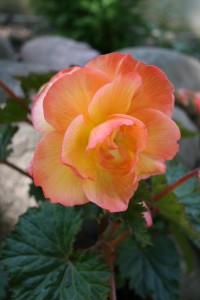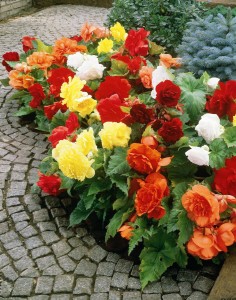Brilliant Begonias!
The next type of spring-planted bulbs we’re going to focus on is the Tuberous Begonia. Known for their wonderful ability to grow in the shade, small habit and lush green foliage, these tubers make great addition to shady gardens and borders. In this article, we’ll review the advantages of using these beauties in your garden, as well as different planting techniques and tips for growing them.
Classification
Tuberous Begonias can typically be grouped into three types: Begonia tuberhybridia, Begonia multiflora, and Begonia pendula. The Begonia tuberhybridia types are the most commonly grown and well-known and include the Double Begonias, Ruffled Begonias, Roseform Begonias, and Picotee Begonias. The Begonia multiflora variety include the Multiple Flowering varieties with smaller, numerous blooms. The Begonia pendula are the Hanging Basket-type of begonias which trail over the edges of planters and pots. Oftentimes, the novice gardener will confuse these tuberous begonias with wax begonias, which are grown more as an annual or indoor plants and not from a tuber (or bulb).
Tubers for all three types of these begonias are typically available for purchase in late winter/early spring. They look like small brown lumps with a depression on one side. When choosing the tubers, be sure to check for firmness and look for those with tiny sprouts on the upper, concave surfaces. This is a good sign that they are healthy and ready to begin growing!
Growing Begonias
As previously mentioned, Begonias should be planted during the spring season, anytime after the threat of frost is gone but before the weather gets too warm. For most of the United States, this time period falls between mid-March and mid-May. Maybe begonia growers located in cooler climates, choose to start their begonias early (middle to end of February) indoors to give them a head start on the growing season. Many bulb companies will over this “early delivery” as on option on this partcular type of spring-planted bulb. (For more detailed information on just how to go about starting these tubers indoors, be sure to check out last year’s blog article here: http://www.bulbblog.com/start-begonias-indoors/)

This Sunrise Scentiment Begonia is of the “ruffled” type and is not only pleasing to look at, but also provides a wonderful fragrance!
Begonias will begin blooming mid-summer and will continue until frost! Begonias thrive in partial to full shade and need to be protected from hot sun and drying winds. The key to successfully growing begonias is to make sure the soild is well-drained. Begonia tubers are extremely susceptible to rot and therefore do not like any excess moisture. However, be sure to not let the soil dry out between waterings during the summer months. Fertilize once per month during the growing season with a water soluble fertilizer (such as Miracle-Grow).Always water the soil around the plants rather than the plants themselves whenever possible to avoid the forming of fungus or mildew on the foliage. The tubers should be planted hollow side up and covered with only 1/2 to 1″ of soil. Planting them too deep will only encourage rotting. Water well after planting to “wake up” the tubers but then not again until you see growth, which usually takes 4-6 weeks.
For aesthetic reasons, pink off extra long stems as the plants grow. This will encourage blooming and keep your plants from looking “leggy”. When growing the hanging basket-type, make sure they have lots of branches to cascade from their plants by pinching out the primary growing tip when the plant is 2″ tall. Also, deadhead your begonias often by removing wild=ted leaves and flowers. This will retain the “clean” look of the plants and will also encourage repeat blooming throughout the season.
Tuber Storage
Once the plants have completed their growing and blooming cycle, the leaves and flower stems will begin to die back as they enter their dormant stage. Begonias are hardy in Zones 8, 9, and 10. In these areas, simply cut the stems back to within 1-4″ of the soil surface once they have completely died back. Leave the tuber in the ground for the remaining fall and winter. If located in zones north of Zone 8 (Zones 1-7), you will need to take special care of the tubers in order to protect them from the harsh winter weather. Southern parts of Zone 7 can usually get away with giving the tubers a good drink of water in the fall and placing a think layer of mulch over the area where the tubers are planted. To be really sure, however, the tubers will need to be removed from the soil and overwintered indoors. To do so, follow these simple steps:
- Since begonia tubers tend to be susceptible to rot, it is often a good idea to bring them indoors just before the first frost. If grown in movable planters, bring the planters indoors and gradually begin with-holding water. Once the leaves begin to die and wilt, remove the stems and leaves carefully from the tubers.
- If your tubers are planted outside in the garden, simply dig them up (plant and bulb together) and bring them indoors prior to the first frost. The foliage will begin dying back quickly and can then be removed.
- Gently brush off any excess dirt from the tubers and place them in a tray or pot with dry sand, peat moss, or vermiculite.
- Store them in a cool, well-ventilated, frost-free area such as a cellar or garage over winter. A temperature of 45-55°F is ideal.
- Replant in the spring once ground has thawed!
Those who grow Begonia tubers are some of the most passionate gardeners on earth…and it’s easy to see why! Looking absolutely gorgeous with their bright, large blooms and lush green foliage, it’s hard to believe these plants don’t need much sunlight! Whether you’re a “begonia growing veteran” or have never tried them before, be sure to make your selections early this year and get them growing as soon as possible!
Have a question about begonias or any other bulb gardening topic? Ask Bridget! Email her at bridget@bulbblog.com! If she features your question in a future post, you’ll receive a Holland Bulb Farms coupon for your next order at Holland Bulb Farms!



